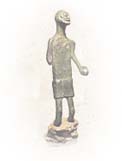 |
|
|
EPT
|
||||||||
|
|
a true open museum
The Giants' Tombs The grandeur of the Nuragic burials has always excited the imagination of the people, giving rise to the popular definition of giants’ tombs when referring to these monuments. Megalithic and monumental – with a huge stele flanked by large upright slabs on the facade (in the most ancient) delineating the exedra, the area designated to cult, or else achieved with rows of megalithic stones – they represent a collective tomb for every one of the village as well as a contact between the living and their ancestors, obviously heroes and founders of their race. The dead were deposed, perhaps with secondary rites, through the small opening into the long sepulchral room covered by tumulus. Aristotle handed us down the incubatory and propitiatory rites practised by the Sardinians, lasting many days in order to regain mental health and to receive omens for important decisions and for the advancement of the clan. The overall shape, an upturned boat for the room or bovine head for the whole is considered symbolic and ritually significant.
The arcaic giant's tomb of S'Ena de Thomes (Dorgali)
|

|
||||||